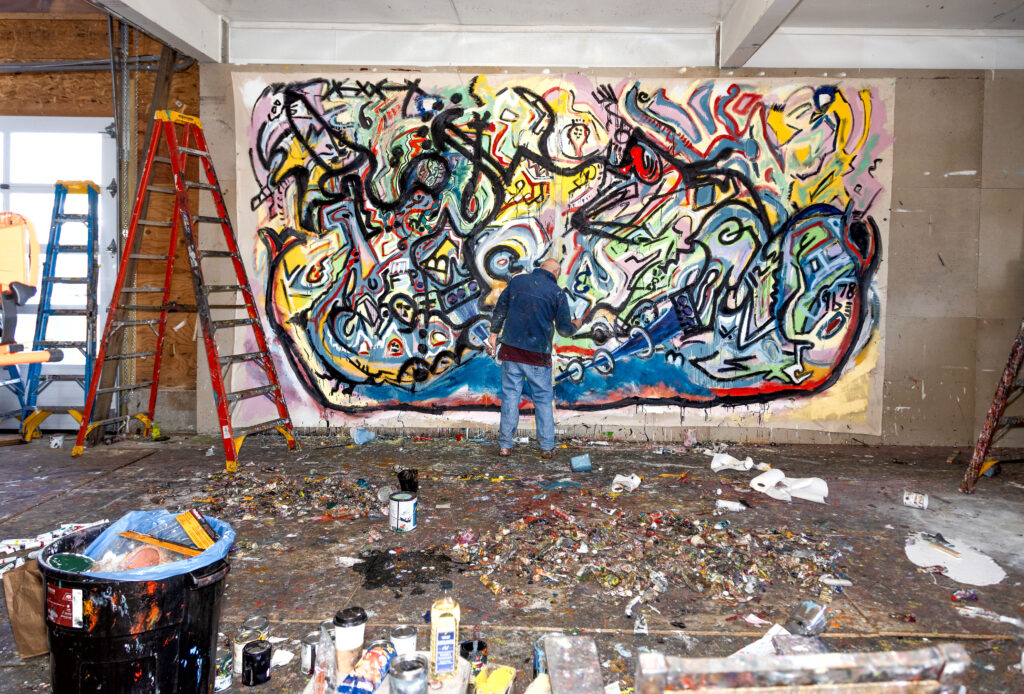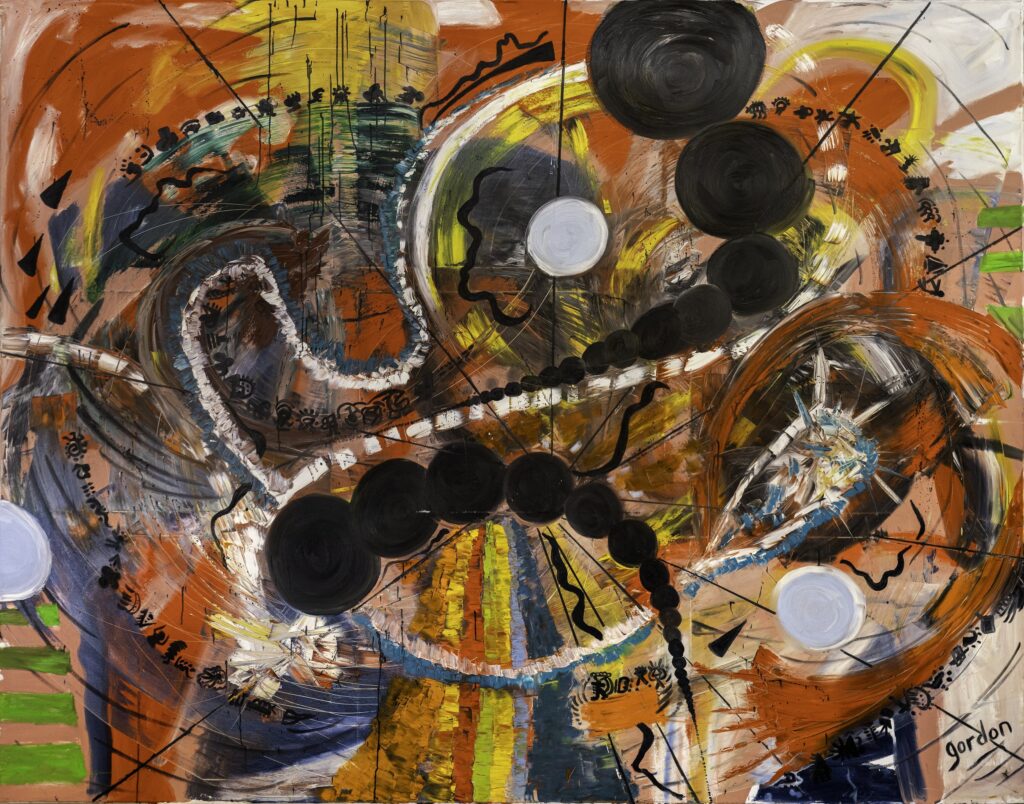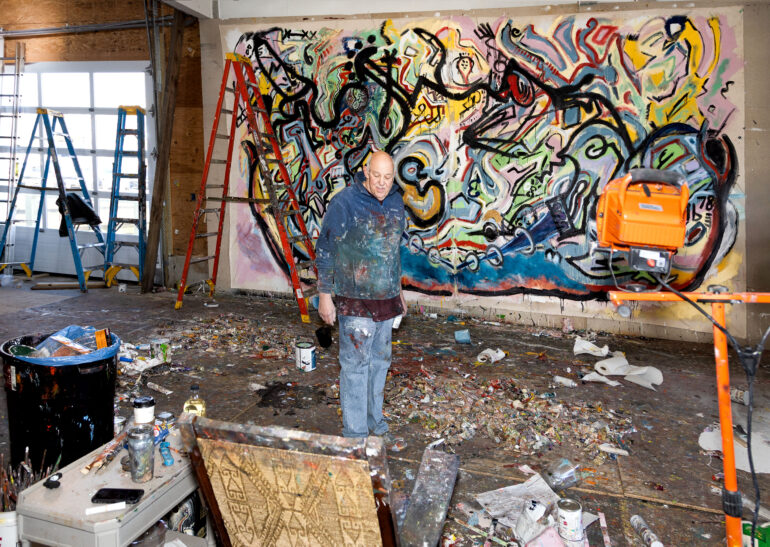Paint Like a Kodiak Bear: Gordon Massman’s Impractically Large Paintings Scream Irreverence, Humor, and the Human Psyche
Gordon Massman doesn’t just paint, he attacks the canvas with raw, emotional urgency. Best known for his wildly expressive, large-scale works, Massman blends abstraction with fragments of myth, politics, and religious narrative to confront the chaos of the human condition. His paintings are feral and unfiltered, saturated with angst, humor, and unflinching honesty. Whether depicting distressed figures or abstract emotional storms, each piece serves as both confession and confrontation.
Culturalee interviewed the poet-turned-painter ahead of his upcoming show GRIT at Alday Hunken Gallery in Atlanta this October, to talk about painting like a bear, laughing through despair, and the brutal beauty of being human.

Gordon Massman ‘Human’s Melting from left and right’.
Your paintings are described as “impractically large” and emotionally charged. What is it about scale that feels essential to conveying the psychological intensity of your work?
I cannot Lindy Hop on a postage stamp. Lindy Hop is fast, athletic, aerial, seductive, acrobatic. The dancers pop, lock, whirl, kick, and lift, as do I with brushes upon large-scale canvases. Such spaces free me to open my chest, like a celestial cabinet chocked with feelings of every hue, from delirium to despair. It’s grand to describe wide arcs with outstretched arms, from six feet high to ten feet high and back to six again, or to stride a twelve-foot crazy-streak fore to aft. Such canvases permit house painter brushes laden with brown to pin-point brushes tipped with plum. Such ecstatic versatility. Such happiness. Such spontaneity. I require spaces big enough to contain exuberance and story and drama in their glorious magnitude. Humans do not love small or suffer tiny. From within confined corporeal boundaries human emotion extends outward and encompasses the world. Sometimes, spiritually, I paint beyond even my largest canvases. Painting for me is a Lindy Hop dance filled with life’s ecstasies and failures.
You’ve said you paint “like a Kodiak bear attacking fresh carrion.” Can you walk us through what a typical painting session looks–and sounds–like in your studio?
Failure does not exist for me for I paint without obedience to professors, critics, or restrictions. My studio represents a blizzard of instinct. A thousand smudged unidentifiable paint tubes clutter the floor, along with a shot blunderbuss of rags, cans, containers, wrappers, screws, jars, and buckets—a whole sticky foundation of junk—the place reeks of oil. All day I am dirty and dirtier, hands like paint mittens, face streaked where I scratch—forehead, ears, neck, sideburns, crotch. Staples crucify the canvas against my painting wall. Tub in left hand, brush in right, I stab, streak, and smash with paint, like the Kodiak bear snatching salmon from their rushing ladders of water. It’s ritual, not fact. Filthy headphones blare everything from Beethoven to Led Zeppelin into my brain. I may or may not take a hit depending on the flow, tempo, and blockage. I shout, “piece of shit,” “go fuck yourself,”“stupid idiot,” and “loser!” I do not eat. Lobster boats slap against three sides of my studio. Nothing peripheral to the work at hand distracts me, save perhaps obsessions with sex and death. It’s survival, not cummerbunds. It’s rush, not savor. It’s vodka, not wine. Five hours a day, six days a week. This is when and where unadulterated freedom exists.
Your work often teeters between chaos and humor, anguish and parody. How do you balance these extremes without diminishing the emotional impact of either?
Humans cannot untangle the mind-heart correlation. Love fails without fear, humor perishes without anguish, joy expires without catastrophe. And these do not arise neatly in opposite pairs but rather uncurl from us in a thigh-thick indistinguishable rope. To tease from the whole the simplicity of pure love, for instance, is to insult the true complex nature of emotional impact. The painting which contains all these feelings is the painting most alive because it is most true to what we are–contradictory, complex, unpredictable creatures. I do not balance these extremes; I landslide them onto canvas.

Some of your paintings draw from mythologies, religious history, and political themes, while others are fully abstract. How do you decide whether a piece will remain non-representational or veer toward narrative?
This decision arrives midway through the painting after we exchange power dynamics: the painting paints me until I seize the brushes. I begin work vaguely rather than rigidly from sketches; I begin without any preconception of what I am painting. After a long tableau of childlike scratching, miraculously—it always happens—a kicking donkey, a bird on a bicycle, Oedipus Rex’s bleeding eyes, a flamenco dancer, a reclining woman cupping a globe, break from the painting and we begin discussions. At that point religious, historical, political, or romantic themes spread roots throughout the paint. At my best I paint wrenching stories, like dreams, torn from the subconscious.
I avoid and generally dislike fully abstract work. The worst, albeit well-meaning, compliment I often receive is: “Oh, Gordon, it’s beautiful!” I do not want to paint beautiful. The highest compliment ever paid to me is: “It’s alive!”
There’s a confessional quality to your work, almost like each canvas is a psychological outburst. How do poetry and painting intersect for you in expressing these inner states?
Freud cracked the world in two. From the depthless cleft psychoanalysis bloomed. He rivalled Jesus Christ in cataclysm. From The Interpretation of Dreams forward, representational art began sliding toward oblivion. While the confessional box provided (and provides) superficial mercurochrome to acts of guilt and shame, psychoanalysis unleashed the magmatic core of unspoken and unspeakable urges, motivations, fantasies, desires, regardless the “ugliness” or “revulsion” therein. Freud unearthed the dark, rich, impregnated soil underlying superficial existence. For me, nothing else exists in the service of art. All is blotted but interiors. Who am I? What am I? Of what depredations am I capable? What are my fears? Which my demons? Am I emotionally unavailable and, if so, why? Why can’t I sustain romantic love? Why do I loathe myself? Why am I so fatally sensitive to criticism? Why am I perpetually hungry?
Plath, Sexton, Lowell, Hughes, Hecht, and Berryman bequeathed to the world the power of confessionalism. They created war in our collective head, where curiosity combats complacency, where Beowulf battles Grendel.
I do not think my paintings (or poetry before) confess anything, for the word confession implies supplication to a sterner law. I say the priest wants confessing as much as the “sinner.”
Hear Ye All! I hereby rename “Confessionalism” to “Realism.”

Titles in your work often carry a witty or ironic twist. How do you approach titling–does it come before, during, or after the painting process?
Because I do not know what I am painting until I paint it, titles emerge deep within the creative process. For example, once on a 10 x 15 foot canvas I began to paint. I painted nothing but raw instinct, one streak demanding another demanding another. I step back from the scrawl, rock in a chair, squint to a blur, pop my eyes wide, grab a tube of radiant pink and engage the work. Several days later my subject breaks out: an exotic Amazonian splendid bird riding a modern racing cycle! There’s the chain, the bird’s feathered body, the mechanical wheels, the whirring motion. Halfway through the painting I title it “Bird on a Bicycle” and fill it out to heart’s content.
I enjoy playful titles which provide an entry point into what may appear to be an indecipherable painting: “Humans Melting from Left to Right” (a political piece), “The Human Male Births a Baby Beside a Backhoe at Midnight,” “The Indomitable Heart of the Blinded Fool,” “Red Riding Hood Gazes Through Night Vision Goggles.” As much as extemporaneous painting, I love open-ended word play.
You’ll be exhibiting in GRIT with Alday Hunken Gallery in Atlanta this October. What can viewers expect from your contribution to that show, and how does the theme resonate with your work?
Among three pieces included in GRIT is a 350 lb. sculpture mounted on an A-frame consisting of antique cutting, ripping, drilling, slicing, and gouging implements screwed to wooden blocks and painted black all spinning out of Donald Trump’s destructive head. His cruelties surround and indict him for the world to see. While I am not expressly a political painter, this piece empowers me beyond my usual solipsism to join my voice with others in protest of outrageous governance. I am particularly proud of this piece. I want this and all my work to embrace, envelop, and impact viewers on an elemental level. “There is the tube of paint, the canvas, and the sum total of your life. That is all.”
Find out more about Gordon Massman here: https://www.gordonmassman.com/about



